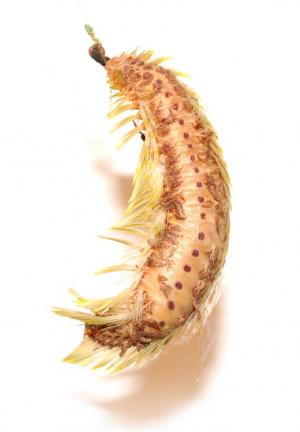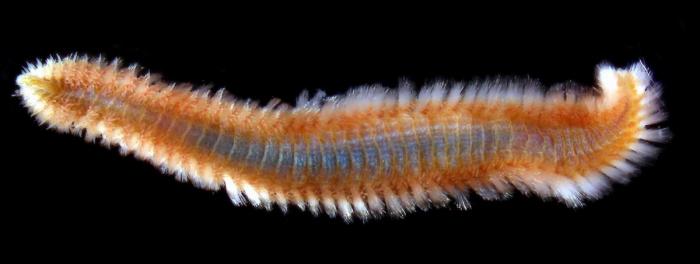Fireworm

Marine worms
Fireworms belong to a group of worms called polychaetes, that mainly live in the sea. Although they belong to the same phylum as other segmented worms such as earthworms and leeches, polychaetes have many features people wouldn’t usually associate with worms. For example they may have eyes, antennae and a pair of leg-like appendages carrying bristles on every segment of their bodies. This type of polychaete looks and moves something like a centipede, although they are completely unrelated to them.
Lifestyle
Some polychaetes are very good swimmers, using their appendages and bristles as paddles or oars. Other polychaetes build tubes and live permanently in them. Many have jaws and are carnivorous, hunting worms and other small animals. Fireworms don’t have jaws, but instead have large and muscular mouths which seize their animal prey before swallowing it whole. Fireworms, including the local Chloeia flava, are also scavengers, feeding on the dead and rotting remains of larger creatures, which is why they are attracted to fish baits!
FIREWORM (Chloeia flava)
People fishing for smaller species of local fish with baits of fish or prawn, sometimes find after a gentle tug on the line, that their bait has been been swallowed by a large, writhing, hairy worm.
The culprit is Chloeia flava, a common inhabitant of the shallow waters of bays and tidal creeks in the Top End, where it is known as a ‘fireworm’ or ‘bristleworm’.
Identification
Chloeia flava, our local species of fireworm, is one of the more colourful members of the Amphinomidae family, and also amongst the largest, with the adults being 8–16 cm long. Their distinctive colouring consists of two rows of bright yellow bristles down each flank and a conspicuous row of purple spots down the centre of the back. On each side of these spots is a row of blood-red branchiae or gills.
Distribution
Chloeia flava and closely related species are common in the shallow tropical seas of the Indo-west Pacific region.
Hazards to humans
The common name for our local species, ‘fireworm’ is painfully evocative of the reaction caused to people if they are handled. Thousands of fine, hollow bristles on the sides of their body easily penetrate skin and break off. This causes painful swelling and intense itching that sometimes lasts for several hours. The exact reason for the reaction is not known for sure, but it is likely the bristles release a toxic fluid when broken.
Further reading
Glasby, C.J. & Bailey-Brock, J. 2001. Bait-taking fireworms (Amphinomidae: Polychaeta) and other polychaetes. The Beagle, Records of the Museum & Art Gallery of the Northern Territory 17: 37-41

